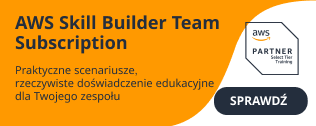Dodatkowe informacje
| Wymagania wstępne | We recommend that attendees of this course have the following:
|
|---|---|
| Poziom trudności | |
| Czas trwania | 3 dni |
| Certyfikat | The participants will obtain certificates signed by AWS (course completion). This course also helps you prepare for the AWS Certified Machine Learning Engineer – Associate MLA-C01 exam and this way gain the AWS Certified Machine Learning Engineer – Associate title – associate level. AWS certification exams are offered at Pearson Vue test centers worldwide https://home.pearsonvue.com/Clients/AWS.aspx |
| Prowadzący | AWS Authorized Instructor (AAI) |
Pozostałe szkolenia AWS | AI and Machine Learning
-

Generative AI for Executives szkolenie AWS
-

Generative AI Essentials on AWS szkolenie AWS
-

Developing Generative AI Applications on AWS szkolenie AWS
2026-02-16 | Warszawa / Wirtualna sala HYBRID: szkolenie dostępne w wersji stacjonarnej we wskazanej lokalizacji lub w trybie zdalnym, w zależności od preferencji uczestnika zarezerwuj -

Advanced Generative AI Development on AWS szkolenie AWS
-

Agentic AI Foundations szkolenie AWS
-

MLOps Engineering on AWS szkolenie AWS
-

Exam Prep: AWS Certified AI Practitioner (AIF-C01) szkolenie AWS
-

Exam Prep: AWS Certified Machine Learning Engineer - Associate (MLA-C01) szkolenie AWS
-

Amazon SageMaker Studio for Data Scientists szkolenie AWS
-

Practical Data Science with Amazon SageMaker szkolenie AWS
CENA SZKOLENIA OD 4500 PLN NETTO
W celu zaproponowania terminu dla tego szkolenia prosimy o kontakt z Działem Handlowym
Najbliższe szkolenia AWS
-
2026-01-21 | 3 dni | Kraków / Wirtualna sala
DevOps Engineering on AWS
szkolenie dostępne w wersji stacjonarnej we wskazanej lokalizacji lub w trybie zdalnym, w zależności od preferencji uczestnika: HYBRID -
2026-01-21 | 3 dni | Warszawa / Wirtualna sala
DevOps Engineering on AWS
szkolenie dostępne w wersji stacjonarnej we wskazanej lokalizacji lub w trybie zdalnym, w zależności od preferencji uczestnika: HYBRID -
2026-01-23 | 1 dzień | Kraków / Wirtualna sala
AWS Security Essentials
szkolenie dostępne w wersji stacjonarnej we wskazanej lokalizacji lub w trybie zdalnym, w zależności od preferencji uczestnika: HYBRID -
2026-01-23 | 1 dzień | Warszawa / Wirtualna sala
AWS Security Essentials
szkolenie dostępne w wersji stacjonarnej we wskazanej lokalizacji lub w trybie zdalnym, w zależności od preferencji uczestnika: HYBRID -
2026-01-26 | 1 dzień | Warszawa / Wirtualna sala
Networking Essentials for Cloud Applications on AWS
szkolenie dostępne w wersji stacjonarnej we wskazanej lokalizacji lub w trybie zdalnym, w zależności od preferencji uczestnika: HYBRID -
2026-01-30 | 1 dzień | Kraków / Virtual Classroom
AWS Technical Essentials
szkolenie dostępne w wersji stacjonarnej we wskazanej lokalizacji lub w trybie zdalnym, w zależności od preferencji uczestnika: HYBRID -
2026-01-30 | 1 dzień | Warszawa / Virtual Classroom
AWS Technical Essentials
szkolenie dostępne w wersji stacjonarnej we wskazanej lokalizacji lub w trybie zdalnym, w zależności od preferencji uczestnika: HYBRID -
2026-02-02 | 3 dni | Kraków / Wirtualna sala
Security Engineering on AWS
szkolenie dostępne w wersji stacjonarnej we wskazanej lokalizacji lub w trybie zdalnym, w zależności od preferencji uczestnika: HYBRID -
2026-02-03 | 3 dni | Kraków / Wirtualna sala
Architecting on AWS
szkolenie dostępne w wersji stacjonarnej we wskazanej lokalizacji lub w trybie zdalnym, w zależności od preferencji uczestnika: HYBRID -
2026-02-03 | 3 dni | Warszawa / Wirtualna sala
Architecting on AWS
szkolenie dostępne w wersji stacjonarnej we wskazanej lokalizacji lub w trybie zdalnym, w zależności od preferencji uczestnika: HYBRID


